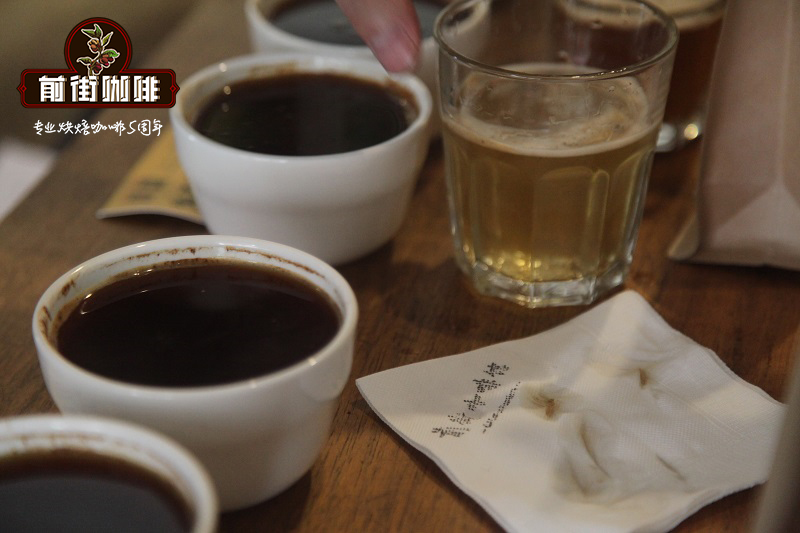Essex Coffee you must know: Essex Coffee Bean Story _ Essel Coffee Bean Brand recommendation

Professional coffee knowledge exchange More coffee bean information Please pay attention to coffee workshop (Weixin Official Accounts cafe_style)
Africa is the world's third largest coffee-producing region, and Ethiopia is the legendary birthplace of coffee! As for Yegashev, it is one of Ethiopia's major coffee-producing regions. At an altitude of 1,700 - 2,100 meters, Arabica coffee beans are mainly produced. And this area has excellent microclimate, all seasons like spring, whether it is sun beans, or washed beans are equally excellent quality!
Yerga Sheff coffee beans are characterized by: smell with a strong floral aroma, drink with citrus fruit and sweet flavor, and fresh tea aroma! Yerga Shev coffee beans rich in layers, there is a delicate body, the aftertaste is also quite long! So Yergashev is a coffee that appeals from name to taste and has a long aftertaste.
What you need to know about Ethiopian coffee
Overview
Land area- 1,104,300 sq km
Capital- Addis Ababa
Trading City- Dire Dawa
Population- 102,374,044 (May 2017)
Spoken - Amharic (official), Oromo, Somali
Producer overview
Coffee practitioners-approximately 700,000
Average plantation area- 1 hectare or less
Annual exports- 3.5 million bags
Coffee Overview
Region- Sidama (including Yirgacheffe), Harrar, Limu, Djimma, Lekempti, Wallega, Gimbi
Coffee Varieties-Ethiopia Superior varieties include Kudhome, Gesha, Djimma, etc.
Treatment-washing, sun
Grading Criteria (Local)- Grades 1 - 9 (Gr 1 - 2 Fine; Gr 3 - 9 Commercial)
Weight of coffee per bag- 60 kg
Harvest period-November-December
Arrival Period- May-July May-June
History of Ethiopian Coffee
Ethiopia enjoys near-legendary status among coffee-producing countries, not only because it is the "birthplace" of Arabica coffee, but also because, unlike most coffee-growing countries, the plant is not a cash crop introduced through colonization. Instead, growing, processing, and drinking coffee has been part of the local way of life for centuries, and coffee first discovered growing in forests has gradually been cultivated for home use and commercial sale.
From an outsider's perspective, Ethiopian coffee has enormous and complex cultural, political and economic implications that are difficult to fully understand. The genetic diversity of Ethiopian coffee is unmatched globally, with 99% of the genetic diversity of coffee varieties found in Ethiopia. Recent reports indicate that the genetic damage to the original Ethiopian coffee varieties due to climate change and variety research should be taken seriously.
Another unique feature of Ethiopian coffee is the very high level of domestic consumption, as coffee plays a very important role in the daily lives of Ethiopians: approximately half of the country's 6.5 million bags of annual production are consumed domestically and approximately 3.5 million bags are exported.
Coffee is still part of a traditional "ritual" preparation, a way for family, friends and partners to reunite. The oldest woman in the family roasts coffee in a pan, grinds it, and boils it in a pot called jebena. She served the thick coffee in a small cup. Then add fresh boiling water and boil the coffee twice more. This process takes about an hour from start to finish, and is a normal manifestation of hospitality.
Most coffee growers in Ethiopia are small-scale farmers, growing less than one hectare; in many cases this cultivation method should be more accurately called garden/pastoral coffee cultivation, where there are some large private coffee farms, as well as cooperatives of small and medium-sized farms, where the growers produce relatively small amounts of green coffee beans for commercial purposes.
Coffee processing and flavor summary
Coffee is produced in several ways in Ethiopia. Large private plantations, where coffee picking, processing and husking are usually done. At the other end,"Garden/Garden Coffee", the individual coffee farmer sends his fresh coffee harvest to the nearest processing station, where his fresh coffee is sold at a price, mixed with the fresh coffee of other coffee farmers and processed according to the requirements of the processing station.
In addition, members of the cooperative Co-op will send their fresh coffee to the processing station designated by the cooperative, which will allow better traceability of coffee since it comes from regular members of the cooperative. With the increasing emphasis on coffee quality and industry transparency, coffee traceability is very important.
The flavor of Ethiopian coffee varies due to a number of factors, including variety, processing methods, and the unique microclimate of the microlots. The general rule of thumb is that sun-cured coffee has a more pronounced fruity and dark chocolate flavor, usually with a bit of wine-like character and a better body. The acidity of coffee processed by washing is also more obvious. Harrar: Coffee is almost always sun-treated and has a distinctive chocolate, nutty flavor profile that reflects the dry climate in which coffee is grown. Sidama is a vast coffee growing region located in the south, including Guji and the famous Yirgacheffe.
Here are some of the more familiar areas of Yirgacheffe:
ADADO: Fine stone fruit, citrus, floral, structurally balanced.
ARICHA: Complex, almost tropical, juicy fruity, sweet with sugar and flowers.
💋BERITI: Prominent floral, composed of a creamy spring thickness, citrus tonality
💋CHELCHELE: Sweet sweetness more like toffee or caramel, almonds, and floral, citrus.
KOCHERE: It's like fruit tea. Citrus, stone fruit
💋KONGA: Peach and apricot-more stone fruit aromas-and a strong lime.
Regarding the spelling of Ethiopian place names: There is a lot of confusion and inconsistency in the spelling of Ethiopian coffee, partly because Amharic does not use Roman letters like English. Therefore, spelling this area Yirgacheffe, Yirgachefe, or even Yirga Chefe is not necessarily wrong. With regard to Sidamo and Sidama, we note that Sidamo is a somewhat derogatory variant of place names, since it should be used in the more acceptable form Sidama.
Ethiopia Commodity Exchange
Ethiopia's Commodity Exchange (ECX) was established by the Ethiopian government in 2008 to give coffee access to markets for agricultural commodities such as soybeans, corn, coffee and wheat. Since Ethiopian farmers usually own very small plots of land, grow only the crops needed for family subsistence and sell surplus crops for cash, ECX believes standardization will be the best way to promote healthy and stable development of the agricultural economy.
ECX strives to remove barriers to trade and give farmers an open, open and reliable market to sell their produce at a relatively stable set of prices. Exchange rules stipulate that any coffee that is not produced by independent private estates or cooperatives needs to be sold through the exchange, thus establishing a system of price and sales guarantees. However, when designing the system, the concept of "specialty" was replaced by commodity, which made it difficult to trace the details of coffee.
Coffee grades are based on uniformity, cleanliness, and defect rate of their physical characteristics, regardless of coffee flavor.
After several rounds of intense negotiations with the specialty coffee industry, a new supplement was added that after coffee was acquired, clear information on the coffee processing station must be provided, but it was impossible to track down the details of the individual producer/grower.
In March 2017, ECX voted to allow direct coffee sales at individual processing stations, which not only increases coffee traceability, but also facilitates the establishment of repeat purchase relationships, a change that increases the likelihood of higher coffee sales prices. The impact of greater traceability and more direct sales on Ethiopian fine coffee remains to be seen, but industry insiders are optimistic.
Ethiopia Coffee Bean Brand Recommendation
Front Street Coffee Freshly roasted single-serving Ethiopian coffee beans-such as Yerga Shefi and Sidamo coffee are fully guaranteed in brand and quality, suitable for brewing in various utensils. More importantly, the cost performance is extremely high, a bag of half pounds 227 grams, the price is only about 70-90 yuan. According to each cup of coffee 200 ml, powder water ratio 1:15 to calculate, a pack can make 15 cups of fine coffee, each cup of coffee only costs about 5, 6 yuan, for coffee shops sell dozens of pieces of a cup price can be said to be extremely cost-effective.
Qianjie Coffee: Guangzhou's baking shop, small store but a variety of beans, can find a variety of famous beans, but also provide online store services. https://shop104210103.taobao.com
Important Notice :
前街咖啡 FrontStreet Coffee has moved to new addredd:
FrontStreet Coffee Address: 315,Donghua East Road,GuangZhou
Tel:020 38364473
- Prev

Comparison of characteristics and flavors in Ethiopian Coffee producing areas _ how much is a pack of Ethiopian coffee beans
Professional coffee knowledge exchange more coffee bean information please follow the coffee workshop (Wechat official account cafe_style) Ethiopia is the hometown of Arabica coffee, it is in the forests of the Kaffa region that you can see wild Arabica coffee. In Ethiopian, coffee is called Bun or Buna, and coffee beans (coffeebean) may be from Ka
- Next

Is the price of Ethiopian coffee beans expensive? introduction of Ethiopian coffee beans. Is Ethiopian coffee good?
Professional coffee knowledge exchange more coffee bean information please follow the coffee workshop (Wechat official account cafe_style) ● Essex coffee bean story Ethiopia is located in a country full of wonders, where all Arabica coffee comes from. The Kaffa Forest is the beginning of everything. Kaffa is located in the southwest of Ethiopia. Centuries of natural progress in Kaffa
Related
- Detailed explanation of Jadeite planting Land in Panamanian Jadeite Manor introduction to the grading system of Jadeite competitive bidding, Red bid, Green bid and Rose Summer
- Story of Coffee planting in Brenka region of Costa Rica Stonehenge Manor anaerobic heavy honey treatment of flavor mouth
- What's on the barrel of Blue Mountain Coffee beans?
- Can American coffee also pull flowers? How to use hot American style to pull out a good-looking pattern?
- Can you make a cold extract with coffee beans? What is the right proportion for cold-extracted coffee formula?
- Indonesian PWN Gold Mandrine Coffee Origin Features Flavor How to Chong? Mandolin coffee is American.
- A brief introduction to the flavor characteristics of Brazilian yellow bourbon coffee beans
- What is the effect of different water quality on the flavor of cold-extracted coffee? What kind of water is best for brewing coffee?
- Why do you think of Rose Summer whenever you mention Panamanian coffee?
- Introduction to the characteristics of authentic blue mountain coffee bean producing areas? What is the CIB Coffee Authority in Jamaica?

